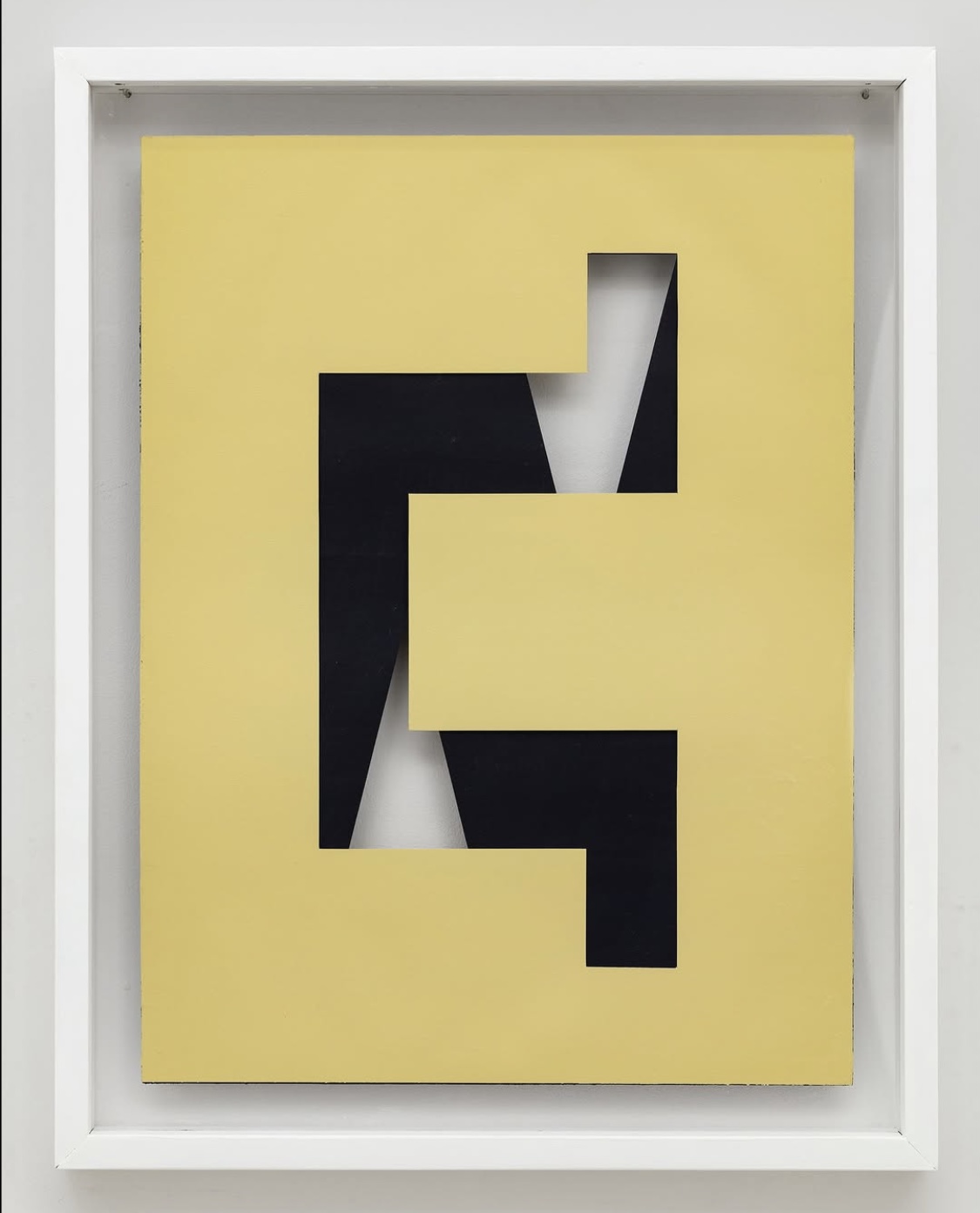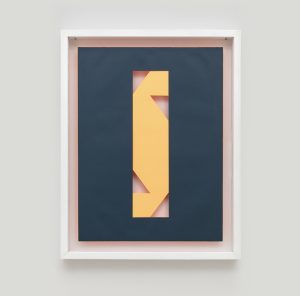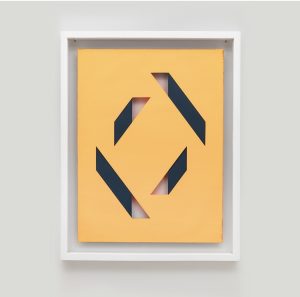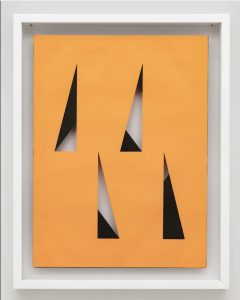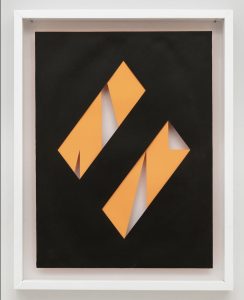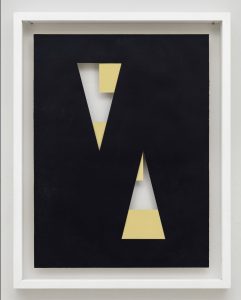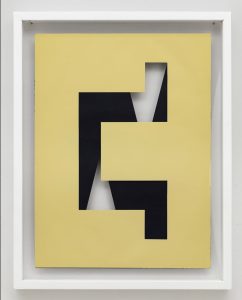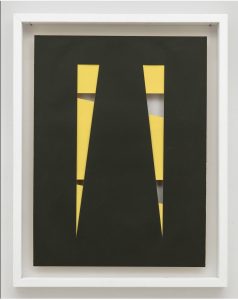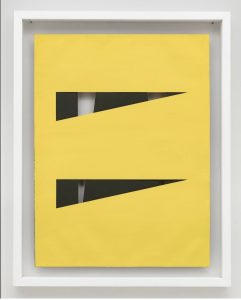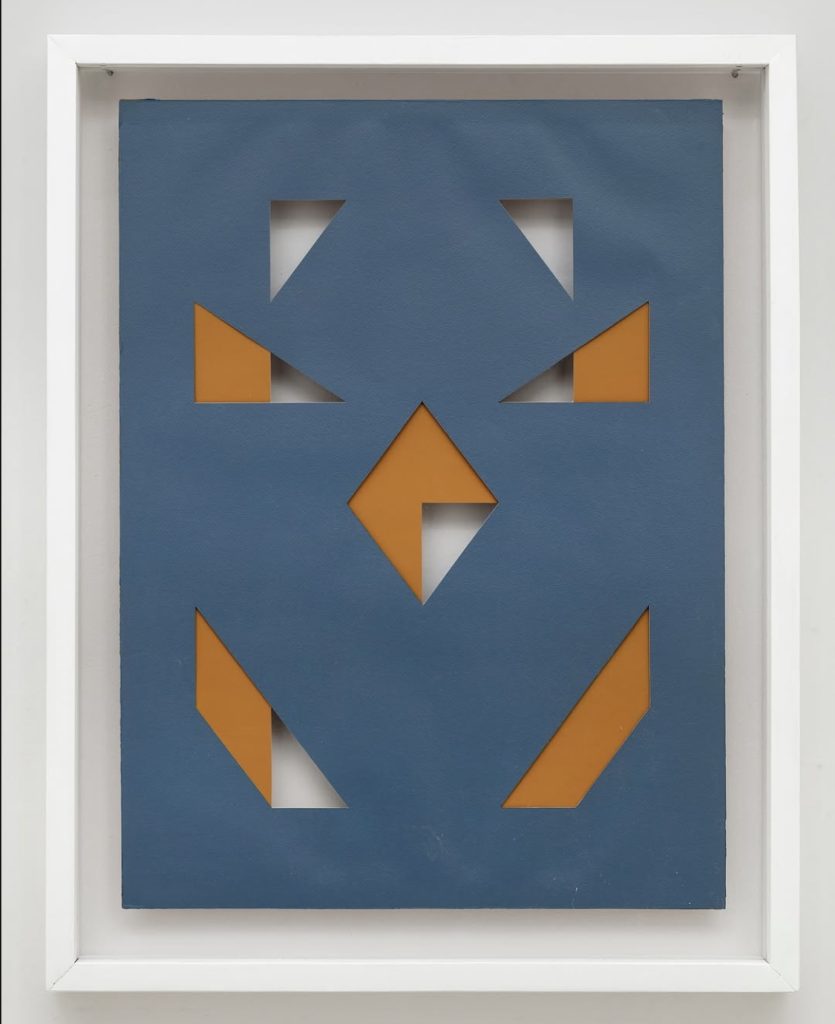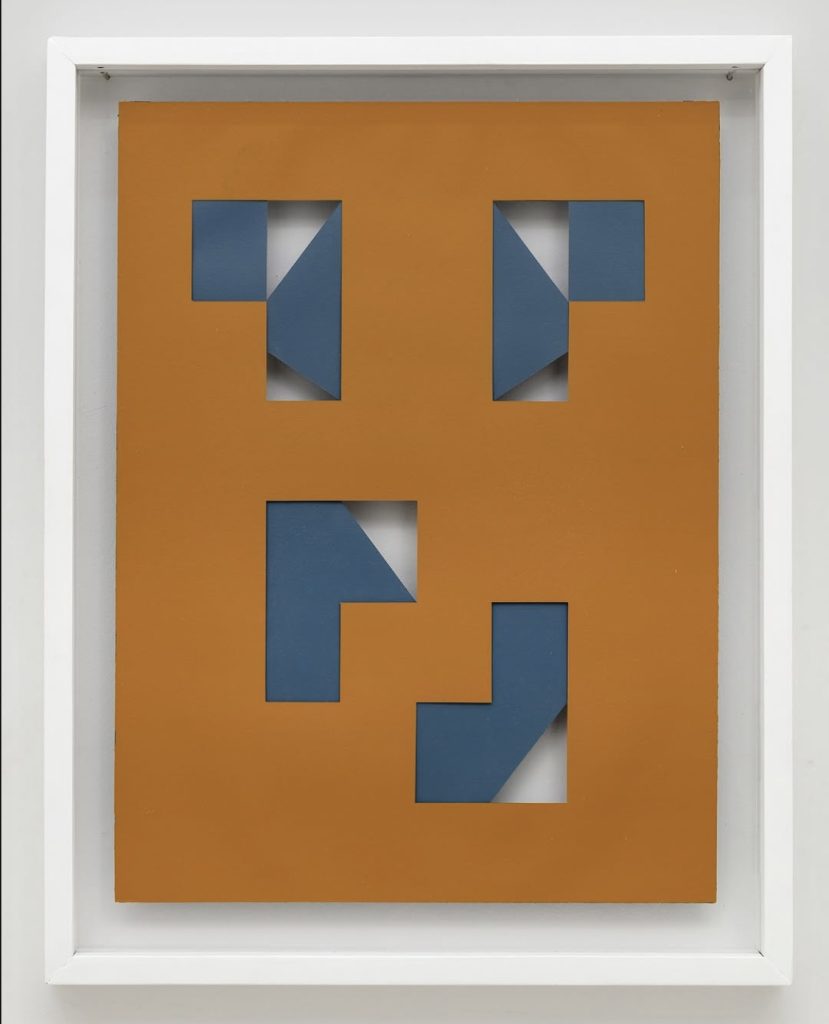Die Ecke Arte Contemporáneo, Santiago de Chile
January 10th – March 30th, 2025
Te regalaré un abismo comes from a homonymous poem written by Roberto Bolaño, which Felipe Mujica (Santiago, 1974) quotes to title his new body of work developed during 2024 and that expands the artist’s conceptual polyphony. It is simultaneously open to the infinite interaction of the series exhibited at Galerie von Bartha in Basel (Switzerland), Proyectos Ultravioleta in Nottingham (UK), and Die Ecke in Santiago (Chile).
In these series, Mujica returns to his origins; the elemental color, form, figure, and background, learned in Eduardo Vilches’ color seminar at the school of art at Catholic University in Chile during the nineties. The incidence of Albers’ color theory–by extension–in his work is manifested in a ludic proposal, a game to experience the alternate relationships of color and figure. Here, the artist proposes a series of artworks on hand-painted paper, with figures created in the exercise of a grid and geometric rules that he has been repeating and differentiating for more than twenty years. Each work, then, is a geometric possibility in front of the same grid, becoming a method, a system, a game that is re-invented, re-created, re-limited with different rules in each series. The game implies a certain order, a structure, limits for the creative exercise, but instead of restricting, knowing the rules of the game gives a space of freedom.
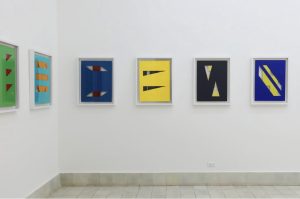
In Te regalaré un abismo, that possibility is translated into cut figures, empty figures–window figures, which give the sensation of openness that something could come through the window. The artworks confront each other and overlap, creating a polyphony of variations and possibilities and, thus, creating new identities. Visual glossolalia, a system of incomprehensible but relational glyphs. Each work does not seek a definitive centrality or position but explores a field of possibilities where form, color, saturation, and light, generally intense and vibrant, differentiate and dialogue. Repetition here does not imply copying or duplication, but an opening, polysemic potentialities. Each artwork accounts for this infinite difference –and repetition, as proposed by Gilles Deleuze. In this sense, the grid Mujica uses, far from being a fixed and static framework, operates as a Deleuzian rhizome, a system that allows infinite connections and reconfigurations. Although the set of features of each unit gives it an identity, by overlapping, the intersection of both units creates a new identity that does not erase or cancel each unit that integrates it. From a post-structuralist aperture, the works suggest the absence and the presence simultaneously, generating a play of meanings that transcends the surface of the pictorial; what Jacques Derrida proposed in 1967 as différance, a notion that underlines the coexistence of absence and presence in the production of meaning. The game addresses the infinite as well as the void –or the abyss, literally and metaphorically. Bolaño continues:
“I’ll give you an abyss (she said).
but in such a subtle way that you will only perceive it
when many years have passed
and you are far away from Mexico and from me.”
In the overlapping of Mujica’s works, there is a ‘between’ in becoming, a space of difference and possibility, where identities are neither fixed nor static, but emerge in the tension between the internal and the external, between solid and empty.
Exhibited in the offices of Galerie von Bartha, 180 works on 300 gr. watercolor paper, A4 size, painted on one side with acrylic paint and gouache, with extracted figures that are individual solutions to the same grid of eight-by-eight sections per side. In addition, the artist installed three Curtains that follow the same principle, they overlap and in the intersecting void, reframe reality. The art interacts with the space, and not only the artworks are re-signified, but also the context is re-signified. It reframes reality, it gives the possibility for something new to emerge in what it enables to be seen.
The second group consists of 20 works on the same paper that will be exhibited in February 2025 by Ultraviolet Projects in collaboration with Beam Editions (Gallery Bookshop) in Nottingham UK. These works are larger (61 x 46 cm.) and this time painted on both sides, erasing the distinctions of verso and verso, with gouache and acrylic, keeping the geometries cut in relation to the same grid.
For Die Ecke Arte Contemporáneo, the artist exhibits a third group (of the same dimensions), a video, and a collective happening with a student workshop to be held at Balmaceda 1215 Cultural Center. The day before the vernissage, Mujica led a workshop to share his methodology; here the game is open, and he uses it to dialogue with young artists enabling the possibility of even new and infinite combinations. The game is re-signified, and rules are the agreement of a collective to carry out a series of actions in a delimited space and time. They recover the notion of non-seriousness, of losing time in the best of senses, time is dilated and is not necessarily productive, but it is a relational experience. It is the abstraction of a utopia, so it removes the oppressive connotation of rules, and exhibiting these, liberates them, not only for the collectivity of the agreements but also liberates them from the notion of inspiration in the pursuit of a relational experience. Also in a collective exercise, they took the cutouts out of the gallery space to insert them and make it dialogue in the public space; the students took all the cardboard pieces to Plaza Julio Prado, a small neighborhood square and playground, where the artist propose experimentation with the light and its shadows, trying out different spatial arrangements and appropriations. Mujica dialogues with the relational qualities of abstraction, in a continuous and collective creation process that opens a ground of immanence where identity and multiplicity coexist.
Carolina Arévalo, curator.
ESP
El título Te regalaré un abismo proviene de un poema homónimo escrito por Roberto Bolaño, y que Felipe Mujica (Santiago, 1974) cita para titular este nuevo cuerpo de obra desarrollado durante el 2024, que expande la polifonía conceptual del artista y que está simultáneamente abierta a la infinita interacción de las series exhibidas en Galerie von Bartha en Basilea (Suiza), Proyectos Ultravioleta en Nottingham (UK) y Die Ecke en Santiago de Chile.
En estas series, Mujica retorna a sus orígenes, hacia lo básico y elemental: color, forma, figura y fondo, aprendido en el curso de color de Eduardo Vilches durante los años noventa en la escuela de arte de la Universidad Católica. La incidencia de la teoría del color de Albers –por extensión–, en su obra es aquí manifiesta en una propuesta lúdica, el juego para experienciar las relaciones alternas de color y foma. Aquí, el artista propone una serie de obras en papel, pintadas a mano, con figuras creadas en el ejercicio de grilla y reglas geométricas que repite y diferencia desde hace más de veinte años. Cada obra, entonces, es una posibilidad geométrica frente a la misma grilla, convirtiéndose en un método, un sistema, un juego que se re-inventa, re-crea, re-limita con distintas reglas en cada serie. El juego implica un cierto orden, una estructura, límites del ejercicio creativo, pero que en vez de restringir, al conocer las reglas del juego, da un espacio de libertad.
En Te regalaré un abismo, esa posibilidad se traduce en figuras cortadas, figuras vacías, figuras ventanas, que dan la sensación de apertura a que algo pudiese venir desde afuera a través de esa ventana. Las obras se confrontan con otras y se superponen, creando una polifonía de variaciones y posibilidades, y así, creando nuevas identidades. Glosolalia visual, un sistema de glifos incomprensibles pero relacionales. Cada obra no busca una centralidad o posición definitiva, sino que explora un campo de posibilidades donde se diferencian y dialogan forma, color, saturación y luz, generalmente intensas y vibrantes. La repetición aquí no implica copia o duplicación, sino una apertura, potencialidades polisémicas. Si bien el conjunto de rasgos propios de cada unidad la dota de una identidad, al superponerse, la intersección de ambas unidades crea una nueva identidad que no borra ni anula a cada unidad que la integra. Cada obra da cuenta de esta infinita diferencia –y repetición, propuestas por Gilles Deleuze. En este sentido, el trabajo de Mujica puede ser entendido desde las perspectivas del postestructuralismo y su conceptualización de la multiplicidad y la identidad en constante devenir. La grilla que Mujica utiliza, lejos de ser un marco fijo y estático, opera como un rizoma deleuziano, un sistema que permite infinitas conexiones y reconfiguraciones. Desde esta apertura las obras sugieren lo ausente y lo presente simultáneamente, generando un juego de significados que trasciende la superficie de la plástica; lo que Jacques Derrida en 1967 propuso como différance, noción que subraya la coexistencia de la ausencia y la presencia en la producción de significado. El juego aborda el infinito como así también el vacío –o el abismo, literal y metafóricamente. Bolaño sigue:
“Te regalaré un abismo (dijo ella)
pero de tan sutil manera que solo lo percibirás
cuando hayan pasado muchos años
y estés lejos de México y de mí.”
En la superposición de las obras de Mujica, hay un ‘entre’ en devenir, un espacio de diferencia y posibilidad, donde las identidades no son fijas ni estáticas, sino que emergen en la tensión entre lo interno y lo externo, lo lleno y lo vacío.
En las oficinas de Galerie von Bartha, 180 trabajos en papel acuarela 300 gr., tamaño A4–de proporción aúrea, pintados por una cara con pintura acrílica y gouache, con figuras extraídas que son soluciones individuales a la misma grilla de ocho por ocho secciones por lado, son exhibidas. Además, el artista instaló tres Cortinas que siguen el mismo principio, se superponen y en el vacío que se intersecta, la obra interactúa con el espacio y no sólo ésta se resignifica, sino que también se resignifica el contexto. Reencuadra la realidad, da la posibilidad de que emerja algo nuevo.
El segundo grupo consiste en 20 trabajos que serán exhibidas en Febrero de 2025 por Proyectos Ultravioleta en colaboración con Beam Editions (Gallery Bookshop) en Nottingham UK. Estas obras son de mayor dimensión (61 x 46 cm.) y esta vez pintadas por ambas caras, borrando la distinción de verso y anverso, con gouache y acrílico y manteniendo las geometrías cortadas en relación a la misma grilla.
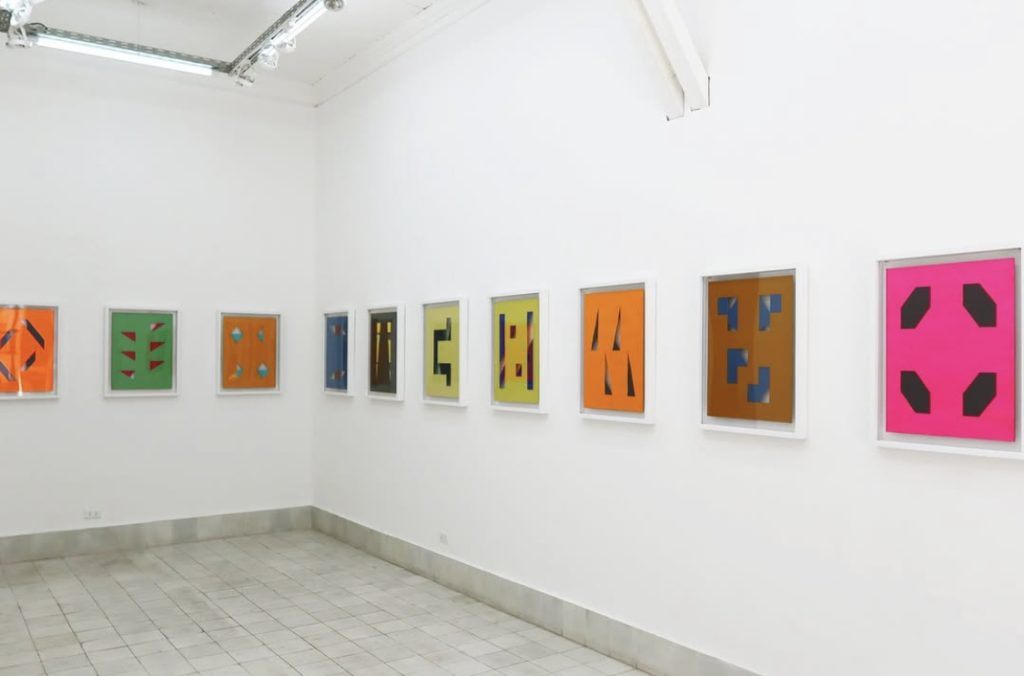
Para Die Ecke Arte Contemporáneo, Mujica exhibe el tercer grupo de obras, de las mismas dimensiones y junto a un video y una acción conjunta con un taller de estudiantes de Balmaceda 1215. El día previo a la inauguración, facilita un taller donde comparte su metodología; aquí el juego es abierto, el artista lo usa para dialogar, abriendo la posibilidad de aún nuevas e infinitas combinaciones. El juego se re-significa, las reglas son el acuerdo de un grupo para llevar a cabo una serie de acciones en un espacio y tiempo delimitado. El juego recupera la noción de la no-seriedad, de perder el tiempo en el mejor de los sentidos, el tiempo se dilata y no es necesariamente productivo, sino que es una experiencia relacional. Es la abstracción de una utopía, por lo que saca la connotación opresora de reglas, y en la exposición de éstas lo libera, no sólo por la colectividad de los acuerdos, sino que además lo libera de la noción de inspiración en pos de lo vincular. También en un ejercicio colectivo junto a los estudiantes, llevaron los cartones pintados y cortados fuera de la galería a la Plaza Julio Prado, la plaza del barrio, donde el artista propuso una experimentación también con la luz y sus sombras, probando diferentes articulaciones y apropiaciones espaciales. Mujica dialoga con las cualidades relacionales de la abstracción, en un proceso de creación continua y colectiva que abre un terreno de inmanencia donde la identidad y la multiplicidad coexisten.
Carolina Arévalo, curadora.
